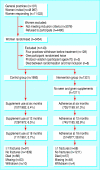Randomised controlled trial of calcium and supplementation with cholecalciferol (vitamin D3) for prevention of fractures in primary care
- PMID: 15860827
- PMCID: PMC557150
- DOI: 10.1136/bmj.330.7498.1003
Randomised controlled trial of calcium and supplementation with cholecalciferol (vitamin D3) for prevention of fractures in primary care
Abstract
Objective: To assess whether supplementation with calcium and cholecaliferol (vitamin D3) reduces the risk of fracture in women with one or more risk factors for fracture of the hip.
Design: Pragmatic open randomised controlled trial.
Setting: Practice nurse led clinics in primary care.
Participants: 3314 women aged 70 and over with one or more risk factors for hip fracture: any previous fracture, low body weight (< 58 kg), smoker, family history of hip fracture, or fair or poor self reported health.
Intervention: Daily oral supplementation using 1000 mg calcium with 800 IU cholecaliferol and information leaflet on dietary calcium intake and prevention of falls, or leaflet only (control group).
Main outcome measures: Primary outcome measure was all clinical fractures and secondary outcome measures were adherence to treatment, falls, and quality of life (measured with the SF-12).
Results: 69% of the women who completed the follow-up questionnaire at 24 months were still taking supplements (55% with inclusion of randomised participants known to be alive). After a median follow-up of 25 months (range 18 to 42 months), clinical fracture rates were lower than expected in both groups but did not significantly differ for all clinical fractures (odds ratio for fracture in supplemented group 1.01, 95% confidence interval 0.71 to 1.43). The odds ratio for hip fracture was 0.75 (0.31 to 1.78). The odds of a woman having a fall at six and 12 months was 0.99 and 0.98, respectively. Quality of life did not significantly differ between the groups.
Conclusion: We found no evidence that calcium and vitamin D supplementation reduces the risk of clinical fractures in women with one or more risk factors for hip fracture. Registration ISRCTN26118436, controlled trials registry.
Figures


Comment in
-
Calcium and vitamin D in preventing fractures: data are not sufficient to show inefficacy.BMJ. 2005 Jul 9;331(7508):108-9; author reply 109. doi: 10.1136/bmj.331.7508.108-b. BMJ. 2005. PMID: 16002891 Free PMC article. No abstract available.
-
Calcium and vitamin D in preventing fractures: dietary intake of calcium needs to be considered.BMJ. 2005 Jul 9;331(7508):108; author reply 109. doi: 10.1136/bmj.331.7508.108-a. BMJ. 2005. PMID: 16002892 Free PMC article. No abstract available.
-
Calcium and vitamin D in preventing fractures: vitamin K supplementation has powerful effect.BMJ. 2005 Jul 9;331(7508):108; author reply 109. doi: 10.1136/bmj.331.7508.108. BMJ. 2005. PMID: 16002893 Free PMC article. No abstract available.
-
Calcium and vitamin D supplementation did not reduce fractures in women >/= 70 years of age.ACP J Club. 2005 Nov-Dec;143(3):72-4. ACP J Club. 2005. PMID: 16262230 No abstract available.
-
Vitamin D and fracture prevention--treatment still indicated but clarification needed.Age Ageing. 2005 Nov;34(6):542-4. doi: 10.1093/ageing/afi184. Age Ageing. 2005. PMID: 16267173 Review. No abstract available.
References
-
- Schurch MA, Rizzoli R, Mermillod B, Vasey H, Michel JP, Bonjour JP. A prospective study on the socio-economic aspects of fracture of the proximal femur. J Bone Miner Res 1996:11: 1935-42. - PubMed
-
- Barret-Connor E. The economic and human costs of osteoporotic fracture. Am J Med 1993:98(suppl 2a): S3-7. - PubMed
-
- Dolan P, Torgerson DJ. The cost of treating osteoporotic fractures in the United Kingdom female population. Osteoporos Int 1998;6: 11-7. - PubMed
-
- Chapuy MC, Arlot ME, Duboeuf F, Brun J, Crouzet B, Arnaud S, et al. Vitamin D3 and calcium to prevent hip fractures in elderly women. N Engl J Med 1992;327: 1637-42. - PubMed
Publication types
MeSH terms
Substances
Associated data
LinkOut - more resources
Full Text Sources
Other Literature Sources
Medical
